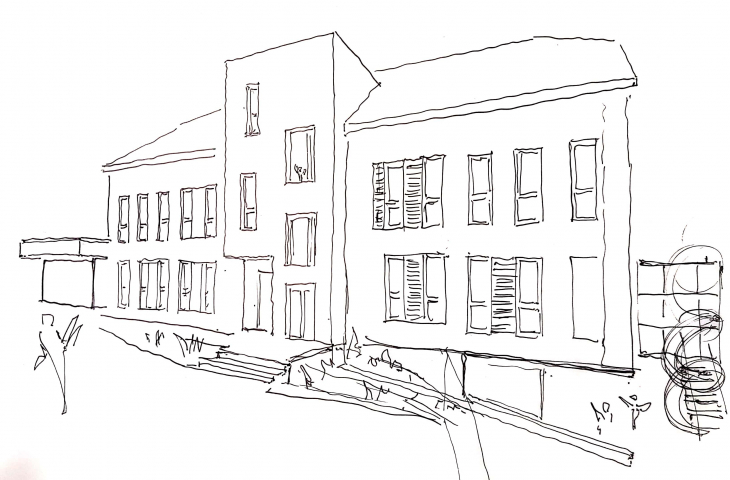In the Żerniki district of Gliwice, a new kindergarten building is being constructed next to Primary School No. 13. The condition of the existing building no longer allowed for use, so the city decided to build a new one in its place. Studio BB Architekci is responsible for the project, which, due to the current Local Development Plan and the historical value of the school buildings, has opted for architecture adapted to the context.
The new kindergarten building will have a multi-pitched roof, covered with ceramic tiles
© Studio BB Architekci
The kindergarten under construction at 13 Elsnera Street in Gliwice is one of four buildings located on a parcel of land included in the MPZP conservation zone. The remaining school buildings are a complex of buildings that has been expanded several times. The last expansion took place in 2018, at which time a three-story school building was added to the main building, referring to the existing architecture. The realization was entered in the competition for the Best Public Space of the Silesian Voivodeship.
The central school building from the middle of the 20th century has distinctive elevations with brick elements, and it was to it and to the neighboring single-family Żerniki development that the architects referred when designing the new kindergarten. They proposed a multi-pitched roof, covered with brick-colored ceramic tiles, and used clinker tile cladding on the elevations.
The new kindergarten is being built in place of the old building
© Studio BB Architekci
In the body of the building, we centrally designed a characteristic cuboidal staircase along with the main entrance. The entrance has been undercut so as to emphasize its location. It is a contemporary accent, as is the cuboid shape of the ground-floor part of the daycare center, which is slightly overhanging and open to the rest of the school grounds
— explains architect Tomasz Bradecki.
The construction of the new, spacious kindergarten is linked to the development of the Żerniki district and the growing needs of SP No. 13. The implementation, financed from the municipal budget, is planned for 2024, and the building will have space for two hundred kindergarteners.
Design of the new kindergarten building in Gliwice, mockup
© Studio BB Architekci
Interview with Tomasz Bradecki
and Barbara Uherek‑Bradecki
Dobrawa Bies: You faced the challenge of designing a kindergarten building, the architecture of which had to adapt to the context and relate to the neighboring school under conservation protection. These are considerable constraints. How do you design under such guidelines?
Studio BB Architects: The context and conservation guidelines dictate the form and material solutions. Despite the fact that the manner of protection was not implemented through the entry in the register, but by the MPZP still the form of the roof, the main body of the building and the roof were already determined in some way. Numerous neighboring school buildings that make up the entire ensemble also define the character of the place, and it is impossible to ignore this.
The kindergarten building is part of the complex of SP No. 13 in Gliwice
© Studio BB Architekci
Dobrawa: It is known that the kindergarten will be built in the place of the old building, whose technical condition no longer allowed it to be used. Has anything of its form been transferred to the designed building?
Studio BB Architects: The old building served the function of a four-unit kindergarten, but it was not originally one. It was realized for housing for teachers who taught in the other buildings. The form of this building is slightly different from the others, so we were not inspired by it.
On the first floor there is an extensive dining room, creating a multifunctional space
© Studio BB Architects
Dobrawa: Please tell us a little about the materials - the facade and form refers to historical buildings, but contemporary solutions were probably used.
Studio BB Architects: Due to the need to reduce costs, the walls were designed with clinker cladding in part and plaster in part. On the contemporary parts of the building, i.e. the cubic form of the staircase and the dining room, the facades were designed to be entirely clinker clad. In other parts, it is plaster with clinker elements and inserts. This refers both to the earlier form of the building and to the previously expanded school building.
Design of the new kindergarten building in Gliwice, projection
© Studio BB Architekci
Dobrawa: What spaces will be created in the new kindergarten? What in particular did you put emphasis on during your design work?
Studio BB Architects: Eight kindergarten departments for different age groups will be created. They will also be equipped with adequate sanitary facilities. An extensive dining room will be provided on the first floor, which will also create a multifunctional space for toddler performances in the late afternoon.
The biggest challenge was to integrate the new building into the plot of land,
on which there is relatively little space and which slopes toward the street
© Studio BB Architects
Dobrawa: What was the biggest design challenge, and what are you most proud of?
Studio BB Architects: The biggest challenge was to integrate the new building into the plot, which has relatively little space and slopes down towards the street - hence the unusual form of partially lowering the building. The functional program is much more extensive compared to the pre-existing building, but managed to plan with a relatively small footprint. It is worth mentioning that this is a unique and unusual school and kindergarten complex with more than a century of tradition, located on a plot where, as a result of historical conditions, there are a total of four buildings.
Dobrawa: Thank you for the interview and I look forward to the implementation of the project.














































